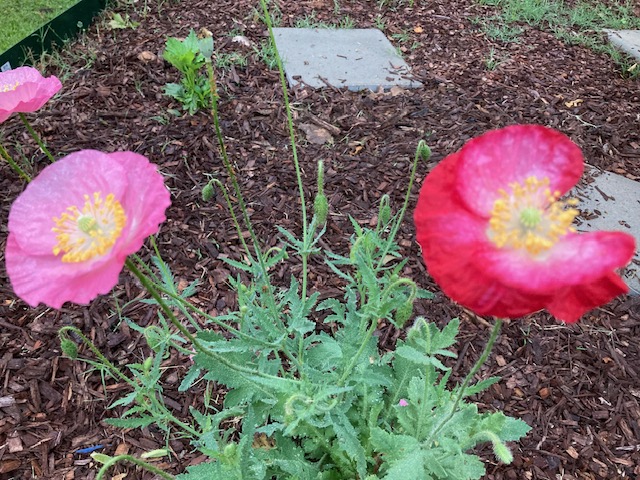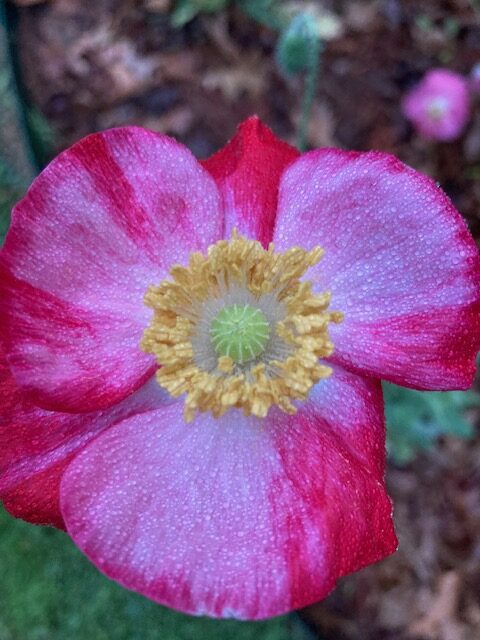
Poppy
There are many varieties of poppy. Some like the breadseed varieties have culinary uses and are the opium poppy. Others like Papaver rhoeas, are associated with WWI due to battlefields blooming with poppies. The seeds can remain dormant for long periods of time. As the seeds need light to germinate when battles disturbed the soil, Papaver rhoeas would bloom.1
|
Falling in Love; Mother of Pearl; Pandora California Poppies are Not a true poppy: California, Sunset |
|
Papaver rhoeas: Falling in Love; Mother of Pearl; Pandora California Poppy: Eschscholzia californica |
|
Easy to Intermediate |
|
Intermediate |
|
3 years if properly stored |
|
Annual |
|
14-21 days |
|
California Poppy: 2 weeks cold stratification. Other varieties: It’s helpful, but not always necessary, to cold stratify for 2 weeks. |
|
Surface Sow |
|
10-12” For most Falling in Love: 18-30” Pandora: 15-25” |
|
Needs light to germinate Full sun |
|
Early Summer to Frost |
|
April, May, and Sep |
|
Yes |

Growing Tips



ONLY for Ladybird 4 plants per 20” container
When to Start
Transplant: Not recommended.
Direct Sow: After cold-stratification and the danger of frost has passed. (May 1 for Jefferson, GA)
Fall: Direct sow in late fall. (October is my best guess for Jefferson, GA)
How to Start
Some gardeners recommend cold stratifying the seeds for 2 weeks to break dormancy before planting. Many authoritative websites, like Burpee, don’t mention this as being necessary. So, you may not need to go through this process for true poppies. However, if you have problems with the poppy germinating, this could be the reason.
The exception to this is the California poppy. It needs 2 weeks of cold stratification. Place the seeds you are going to sow in the refrigerator for 2 weeks before direct sowing after the danger of frost has passed.
Direct Sow in late Fall. Nature will take care of any cold stratification over the winter.
Care
Poppy is typically easy to grow. However, humidity and improper watering techniques can make growing poppy challenging. Sow poppies evenly and thinly into poor to average soil in a full sun bed. Gently press into the soil or barley cover to keep it from blowing away, as poppy seeds need light to germinate. Keep the seeds evenly moist throughout the germination process. Thin them to 12 inches when the plants reach 2 inches high. Then mulch to help keep weeds down.
Poppies grow a taproot. When this taproot is disturbed in transplanting, a lost season of bloom may occur. That being said, transplanting can be done with limited results. Just transplant when they are very young, before they get too mature to avoid disturbing the taproot. This can be tricky, which is why it’s not recommended. Dead-head the plant to encourage more blossoms, until you are ready for it to go to seed.
Poppy flowers need limited watering once they have settled into their location. Too much water can result in tall, leggy, unattractive growth of the growing poppy flower. Water to a depth of 1 inch weekly. Water in the morning and use soaker hoses to keep the plants healthy. See Tips and Tricks for more info.
To overwinter perennial varieties, add 1-2 inches of mulch in the fall. Cut back foliage after it has died back. If the poppies need dividing, do so in autumn to allow time for the taproot to restore itself.
My personal experience
Poppy’s are my favorite flower. They are just so beautiful and delicate! But they sure are a challenge to grow in GA. I’ve tried every year for several years now to grow poppies with varying success. Poppy in GA needs proper spacing as it will get a fungus otherwise.
I have the most luck with volunteer plants verses transplanting. I know you’re not supposed to transplant, but I do it anyway. It usually works at home. Haven’t gotten it to work in the Library garden yet. You just transplant when they are very young and do your best not to disturb the roots.
My next experiment is to try sowing in the fall. I’m hoping this will proove to be a success. By letting the seeds over winter, this should give the seeds the cold-stratifcation they seem to like and it avoids the whole root disturbance issues. We’ll see how this goes!


My first time
My first time planting poppy I grew Shirley Temple mixed colors. I just loved that I could get 3 different colors of flowers on one plant! They ranged from this bright red to a light pink to a mix of the two. Gorgeous! Isn’t it!
Seed Saving

Isolation Distance
Insect dependent for pollination. Isolate 300 feet to prevent cross-pollination.
Instructions
Select healthy, robust plants free of any signs of disease or insect infestation for seeds. Seeds carry the traits of the parent plant. Choose plants that exhibit the traits you wish to preserve. Consider bloom size, color, and shape, as well as blooming time.
Allow the biggest and healthiest blooms to mature on the plant. Cover the seed head with a fine-mesh bag as soon as the flower petals shrivel and die. Use an elastic band to hold the bag in place. This prevents seeds from spilling onto the soil before harvest.
Clip the flower head from the main stem once the seeds are dry and dark. Separate plant debris from the seeds by removing the mesh bag and placing the flower head in a paper bag and shaking to loosen the seeds. Seeds settle to the bottom of the bag. Remove plant debris by hand.
Features
- Attracts pollinators
- Dry area tolerant
- Generally easy to grow and maintain
- Falling in Love: Heirloom. The semi-double blooms come in jewel tones of coral, salmon, rose, and cerise!
- Mother of Pearl: Heirloom. Blooms range from gray, lilac, mauve, pink, soft orange, and white.
- Pandora: Prolific blooms in shades of deep burgundy-red, pinkish-red, and striped with silver-gray.
California Poppy (Not a True Poppy)
- California: While called a poppy, the California poppy isn’t an actual poppy. It has brilliant, golden-orange poppy-like blooms that remain until frost. Fun fact, it’s California’s state flower.
- Sunset: Its blooms come in colors that range from cream to red.

Poppy is susceptible to various fungal problems. Botrytis (gray mold); downy mildew; powdery mildew, as well as root rot.
To help prevent these problems, avoid overhead watering. Provide adequate drainage and avoid overwatering. Use soaker hoses for bottom watering and space/thin plants to allow for good air circulation. Remove any plants that get Botrytis to prevent spread to other plants. And rotating plants will help prevent the spread of disease.
For any pest problems see Pest Management for ideas.
You May Also Like:
Sources:
Gardenguides.com
Starting & Saving Seeds by Julie Thompson-Adolf
Burpee.com
